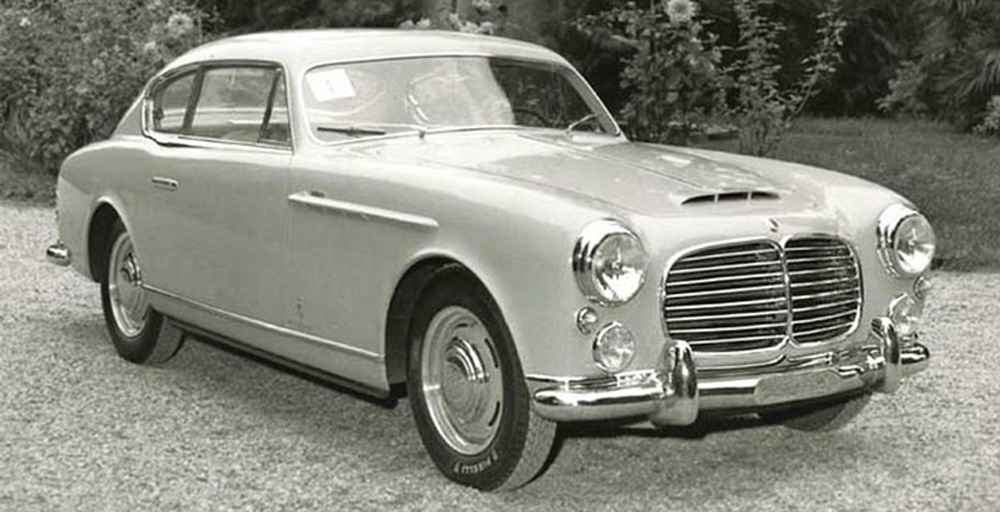
Maserati’s A6G 2000 was a production sports car introduced in 1950 to replace the A6 1500. In the name A6G 2000 the “A” stood for Alfieri in honor of company founder Alfieri Maserati who passed away in 1932, “6” indicated the number of cylinders and “G” stood for Ghisa, acknowledging the cast-iron technique used to construct the engine blocks – however, Maserati soon reverted to alloy castings. The 2000 figure denoted the displacement expressed in cubic centimeters, i.e. 2 liters. Both bore and stroke had been increased from the previous 1.5 liter model. The straight-six featured a chain-driven overhead camshaft, with a three-carburetor set-up allowing the engine to produce between 90 and 100 hp and gave a top speed of between 160 and 180 kph (100 to 113 mph), depending on engine developments. Chassis dimensions remained unchanged, but the rear suspension was updated with cart-springs derived from those featured on the Fiat 1100.
The Maserati A6G 2000 was unveiled at the 1950 Turin motor show with Pininfarina coachwork. Pininfarina built nine four-seater fastback coupes, all characterized by a high waistline. Frua of Turin supplied five convertibles plus a single coupé, while Vignale also added a one-off coupé penned by Giovanni Michelotti. All 16 cars in the short production run were assembled between 1950 and 1951, although the model was only replaced in Maserati’s line-up in 1954 with the introduction of the heavily revised A6G/54. Hand-built and highly exclusive, the A6G series firmly established Maserati as one of the finest manufacturers of sports cars in the world thanks to the model’s quality, refinement and performance.
Maserati A6G 2000 Technical Specifications
| Model | A6G 2000 |
| Maserati internal code | Tipo A6G |
| Production start | 1950 |
| Number Produced | 16 |
| Ignition | single-plug, Marelli ST95DAS coil ignition |
| Lubrication | forced with single oil pump |
| Transmission | 4-speed + reverse, rear wheel drive, dry multiplate clutch |
| Reduction | 1:4.4 |
| Gear ratios | I= 3.68; II= 1.78; III= 1.35; IV= 1 R=6.20 |
| Chassis | tubular steel with four main longitudinal side members and cross members |
| Front suspension | independent with coil springs and hydraulic Houdaille dampers |
| Rear suspension | rigid axle with longitudinal leaf springs and hydraulic Houdaille dampers |
| Brakes | hydraulic drum brakes on all four wheels |
| Steering | worm and sector |
| Cooling system | water-cooled, centrifugal pump |
| Dimensions | |
| Length | 160.63 inches (4,080 mm) |
| Width | 59.84 inches (1,520 mm) |
| Height | 53.15 inches (1,350 mm) |
| Wheelbase | 100.39 inches (2,550 mm) |
| Front track | 1,274 mm |
| Rear track | 1.251 mm |
| Dry weight | 2,425 lbs (1,100 Kg) |
| Tires | front/rear 5.50×16 |
| Wheels | steel or wire wheels, 3.50×16 |
| Top speed | 99 mph (160 km/h) |
| Bodywork | two-door, 2+2 coupé or spyder |
| Fuel tank | 12.65 Imperial gallons (55 liters) |
| Range | 300 km |
| Production dates | 1950-1953 |
| Engine | straight 6 |
| Bore and stroke | 72×80 mm |
| Total displacement | 1,954.3 cc |
| Displacements (unitary) | 325.7 cc |
| Compression ratio | 7.8:1 |
| Maximum power | 100 hp at 5,550 rpm |
| Timing gear | two valves per cylinder, single overhead camshaft |
| Fuel feed | naturally aspirated with three Weber 36 DO2 carburetors (or a single 40 DCR) |

You must be logged in to post a comment.